 |
||
|
||
| ||
 I think you understand the idea of the conflict reflected in the poem above. While the offspring of STMicroelectronics and Imagination Technologies - KYRO was of little interest for NVIDIA, since it wasn't dangerous for low-end products of NVIDIA, the second generation of this graphics processor (the KYRO itself is the third stepping in the PowerVR series) causes Nvidia much concern. And why NVIDIA? Having released a whole series of chipsets for users from those with full wallets to those with empty pockets and having seized the lion's share of the video card market, this company fears any competitor that can launch a cheaper but more powerful product. ATI is still competing successfully with NVIDIA, having its video cards in each market sector (apart from the most expensive and powerful), but today NVIDIA doesn't much worry about it since their sales volumes are too different (except RADEON LE, produced not by ATI itself, but by its partner). Secondly, video cards based on NVIDIA chipset can undergo price decreases; for example Nvidia can handle the price of a Geforce2 MX card falling by $50, a price drop ATI can't match. The RADEON LE is selling just a bit higher than its optimal price. And the situation with KYRO II is different. First, the production of such video cards is cheap (the processor is not expensive, plus cheap SDRAM is used), that is why it can be more attractive for various Chinese and Taiwanese companies to manufacture, secondly, an improved technology of the chip production allows for a performance level somewhere between GeForce2 MX and GeForce2 GTS. It means that the card will be cheaper than a GeForce2 MX based one, and the efficiency can be higher. At first sight, this is the case - for detailed specifications refer to the KYRO II review. I think that Guillemot understands this perfectly. That is why they have launched a new card the Hercules 3D Prophet 4500 based on KYRO II. But not everything is so easy. First of all, the KYRO II is not such a perfect hero (refer to our in-depth review of this processor). Of primary concern is the maturity of the card's driver software. The technology used in the KYRO II has some drawbacks dealing with trilinear and anistropic filtering which, when enabled, cause significant performance dr ops. Its important not to neglect these important functions, however they can be disabled to give the card a large speed gain. Besides, market policy plays a vital role for the KYRO III. First of all, the current market is defined by the struggle of Nvidia against this processor, which means the majority of video card manufacturers would be afraid to raise the wrath of such a powerful graphics processor supplier. Only Guillemot is out there ignoring Nvidia and releasing the 3D Prophet 4500. Since Nvidia is closely partnered with them, they allow Guillemot to get away with it. But will Hercules be able to oppose the colossal market of the GeForce2 MX-based video cards alone? I doubt it. Its almost an impossible feat: we have already seen the poor market position of ATI, the death of 3dfx, and Matrox leaving the high-end video processor market. Of course there is still VideoLogic, but this division of Imagination Technology has small facilities and the prices of VideoLogic cards are much too high to be competitive. However, time will show who is who and whether Hercules will manage to promote its new product. There is not much time until the mass sales start, and now we will turn to the Hercules 3D Prophet 4500 itself. I won't consider aspects concerned with a tile architecture of the KYRO/KYRO II, as well as the detailed analyses of its operation since we have already written about it in our review. Let's just look at the 3D Prophet 4500 and compare its performance and quality with its competitors. CardThe Hercules 3D Prophet 4500 has AGP x2/x4 interface, 64 MBytes SDR SDRAM located in 8 chips on the right and back sides of the PCB. 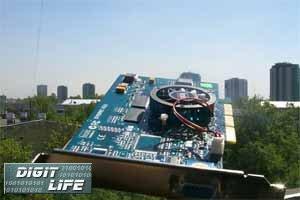  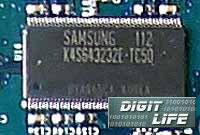 Samsung produces memory chips with 5 ns access time which corresponds to 200 MHz. But the memory works at 175 MHz, as does the chip itself, which is concerned with the fact that the processor and memory frequencies are synchronized. That is why the memory has some overclocking potential. However, they say that they will equip only the first lots of cards with such memory, and the following ones will get 5.5 ns one. Anyway, it is not very important since overclocking is limited by the chip frequency. The card's design is much similar to one we have seen on the reference card from Imagination Technologies. The difference lies only in additional memory chips on the back side of the memory, thus the totalling 64 MBytes. The PCB is traditionally sky-blue, it has blank spaces for chips intended for TV-out and DVI, the corresponding connectors are also absent. The GPU is equipped with a roundish cooler with an effective fan. But is reportedly not a modified Blue Orb from ThermalTake.  The card is shipping in a Retail-package of traditional dark colors with a bright picture of a soldier or a magician. The box contains:
OverclockingThe Hercules 3D Prophet 4500 managed to reach a maximum of 190/190 MHz. Of course, it is not compared to the rated 175/175 MHz frequency, but until today none of the KYRO/KYRO II based cards in our lab could work at a frequency higher than 5 MHz over the rated value. That is why it is interesting to look at the performance gained with such overclocking. Note that we overclocked the sample with PowerStrip 3.0 beta123. Installation and driversTest system configuration:
ViewSonic P810 (21") and ViewSonic P817 (21") monitors were used. For testing we used drivers from STMicroelectronics of 7.89 version; VSync was off. For comparison the results of the following cards are shown: SIGMA Cyber5500 (GeForce2 MX), SIGMA Cyber6000 (GeForce2 GTS), ATI RADEON 32 MBytes SDR, ATI RADEON 32 MBytes DDR, ATI RADEON 64 MBytes DDR (183MHz), ABIT Siluro GF256 (GeForce2 GTS 64 MBytes) ,reference card STM KYRO II 32 MBytes. Benchmark resultsAs for 2D graphics it should be noted that the quality is very good, even excellent. A sharp image can be seen up to 1600X1200 (75 Hz). A similar level is demonstrated by NVIDIA GeForce2 GTS cards from brand-name manufacturers. Now comes 3D performance. Here we used the following programs:
Quake3 Arenademo002The tests were carried out in two modes: Fast (shows card's work in 16-bit color) and High Quality (shows card's work in 32-bit color). 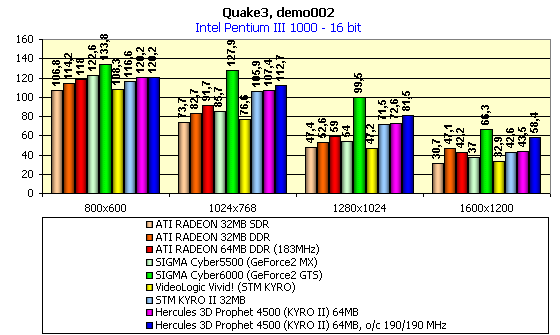 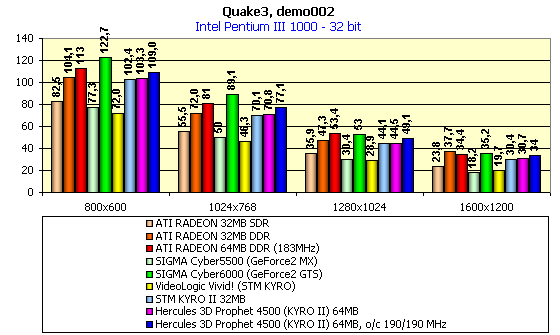 With these diagrams we can estimate the position of the Hercules 3D Prophet 4500 among other video cards in the market segment. The purple and blue columns show the results of the card at the rated and increased frequencies. In 16-bit color the KYRO II falls only behind the GeForce2 GTS. And only in 1600X1200 does it go on a par with ATI RADEON DDR in speed. The KYRO II shows its unique tile-based architecture might not suffer the performance hit seen on more powerful cards (that have more rendering pipelines and texture blocks) when processing complex scenes. Think back to our first review where we talked about the perfect image quality of the KYRO II in 16-bit color. Also note performance when the card is overclocked, which increases even more as resolutions are increased. If an enhanced KYRO II could be produced - something like a Pro-version with frequencies in the 200 MHz - 220 MHz range, the card would boast performance higher, especially at higher resolutions, than a GeForce2 GTS, which wins today throught its 4-pipeline architecture and 8 texture blocks. In 32-bit color, the ATI RADEON cards perform better, with the Hercules 3D Prophet 4500 coming in at the level of a 32 MBytes RADEON DDR, but a bit behind the 64 MBytes RADEON (which runs at 183MHz). Nevertheless, the Hercules with its SDRAM and a chip with 2 texture blocks returns scores equal to a card with DDR DRAM and a processor with 6 (4 active) texture blocks. And even the GeForce2 GTS is only slightly ahead. Note that in this case such a slight overclocking is not enough of a performance increase for the Hercules 3D Prophet 4500 at higher resolutions, which is explained by the fill-rate of the card, which is comparatively small because of the 2 pipelines of the KYRO II. QuaverThe testing was carried out in 16- and 32-bit color at the maximum quality (geometry detailing is High, a toddler of the texture detailing level is in 4th position). 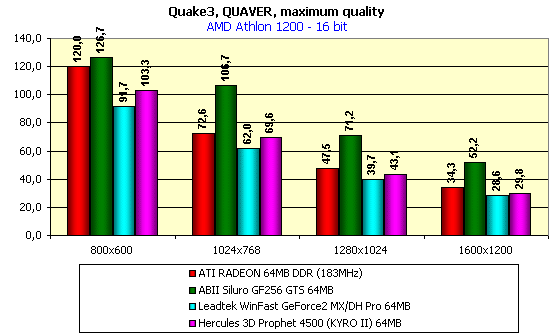 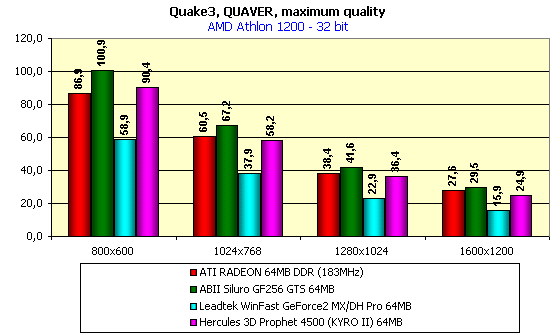 In this test texture pumping speed via AGP plays a vital role, since the total size of textures is huge, and it means that in the case of 32-MB cards everything depends on the correct work of drivers supporting AGP (in this case - the VIA AGP-driver), as well as on an optimization of operation of video card drivers with AGP-drivers from VIA. Considering that the Hercules 3D Prophet 4500 has 64 MBytes memory, thus nearly independent from the transfer rate via AGP, I have decided that it is correct to compare this card with 64-MB competitors. In 16-bit color the KYRO II and RADEON DDR show nearly identical results with the GeForce2 GTS falling behind dramatically. In 32-bit color the GeForce2 GTS's performance is limited by the lower video memory bandwidth, and the first place taken by this card is not very important. And the KYRO II and RADEON DDR keep together as well. In 32-bit color the Hercules 3D Prophet 4500 is closer to the GeForce2 GTS in performance than to the GeForce2 MX. But comparing the prices of 64-MB RADEON in a Retail-package (183 MHz), 64-MB GeForce2 GTS card with the price of the Hercules 3D Prophet 4500, the conclusion is obvious. Anti-aliasingThe tests were carried out in two modes: Fast (shows card's work in 16-bit color) and High Quality (shows card's work in 32-bit color). 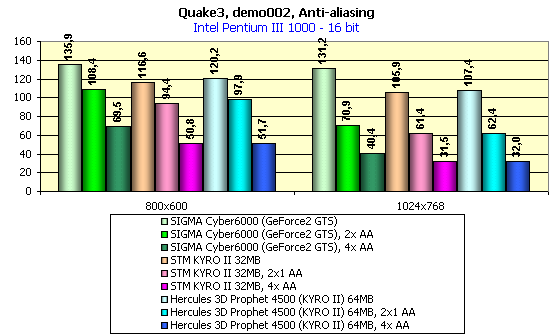 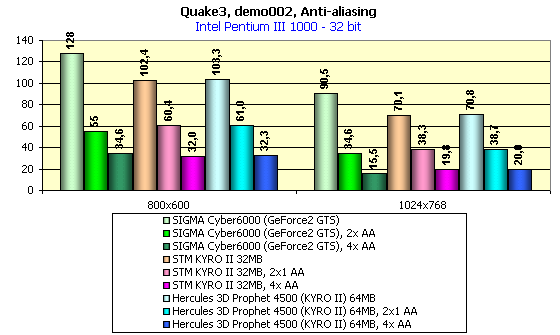 In our first review we have considered this effect in detail. Today I can show once again that the performance falls drastically with the AA enabled, which contradicts the popular idea of this effect being not resource-hungry in case of tile architecture. But for the realization of super-sampling this architecture alone is not enough, the fill-rate should be very good, what is not typical for the KYRO II. Nevertheless, with the AA enabled the KYRO II and GeForce2 GTS show nearly the same performance. Despite having the huge fill-rate of the GeForce2 GTS, it has another gross drawback - a low memory bandwidth. 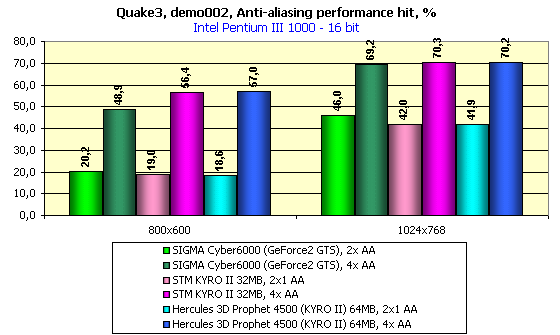 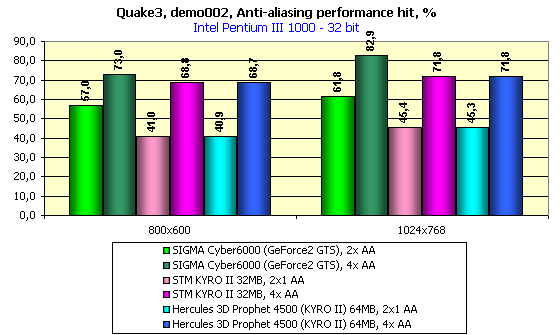 The diagrams above show the performance decrease with AA enabled, percentage wise. In 32-bit color the performance drops more in case of the GeForce2 GTS since the speed without AA was higher. Scalability, performance dependence of the CPU frequencyLet's consider it with respect to resolutions:
 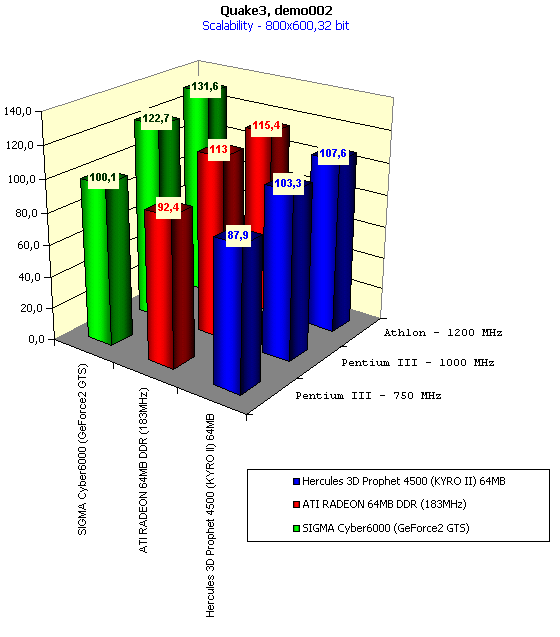 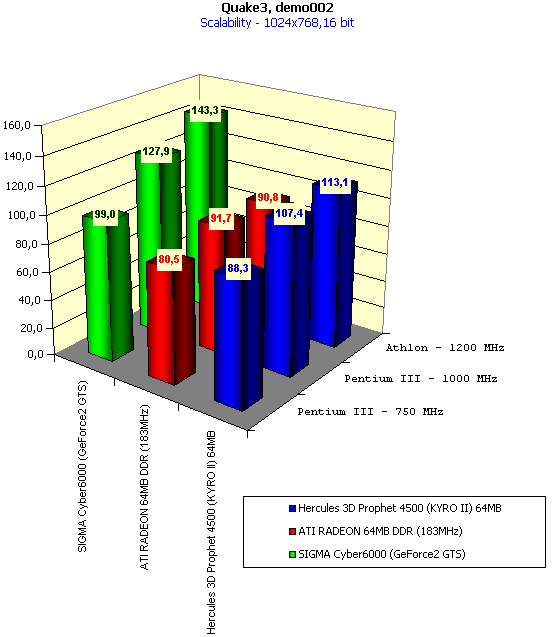 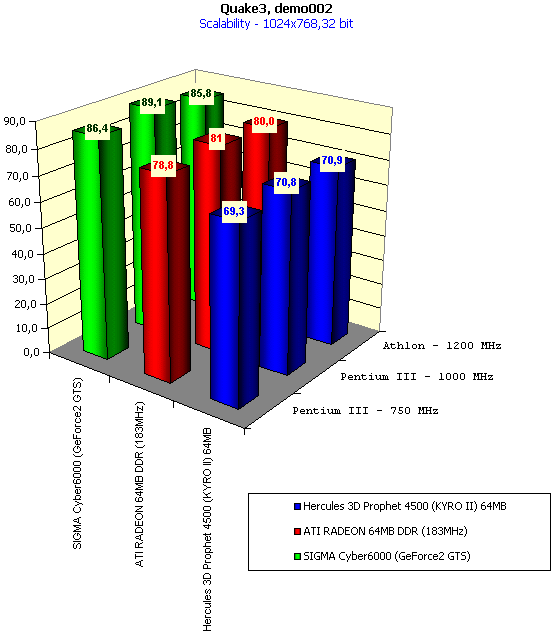 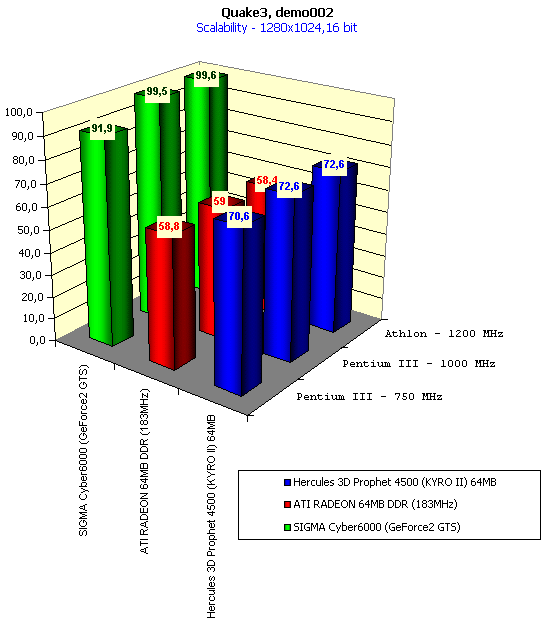 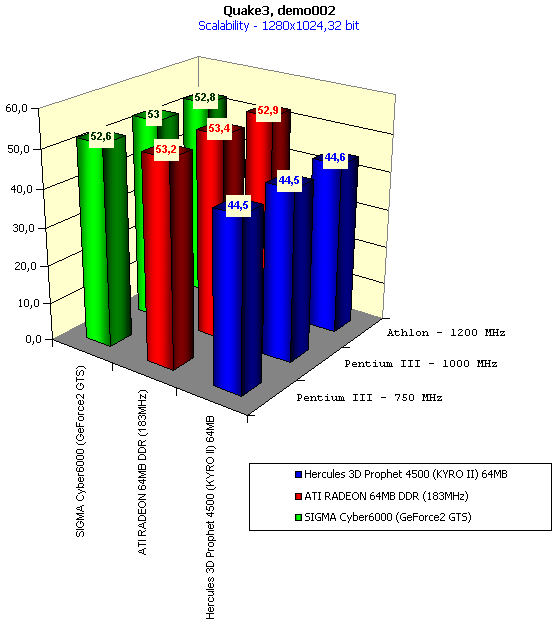 GiantsThis game is used to show the card's speed in Direct3D. 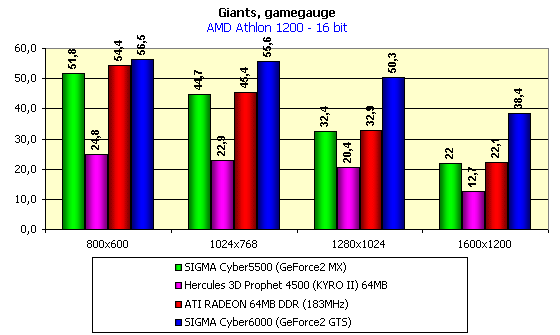 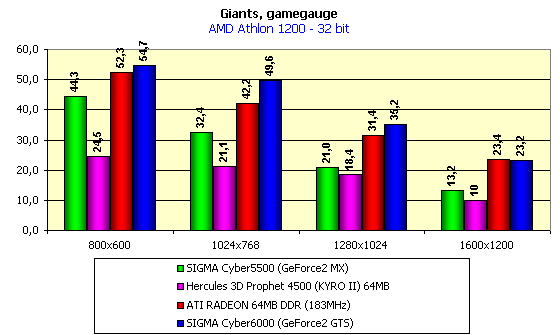 Until now the situation with the Kyro II looked good, but now we have started a heavy application with complex scenes and Hardware TCL. So what can we see? Even the GeForce2 MX card easily outscores the Hercules 3D Prophet 4500. Of course, the testing was carried out at the maximum quality and relief texturing effects (Dot3 and EMBM) and cube texturing enabled. That is why this test was difficult for all cards. Yes, the tile architecture does have some advantages, and they are really useful in games where overdraw is high when a traditional architecture makes the GPU process all objects, even invisible ones. And tiles allow to avoid unnecessary calculations. We can see it on STM techno-demo programs which have scenes with a great overdraw, where the KYRO outscores the competitors: 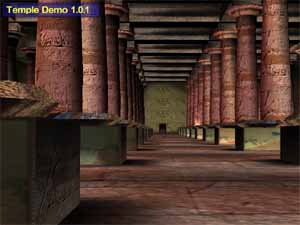 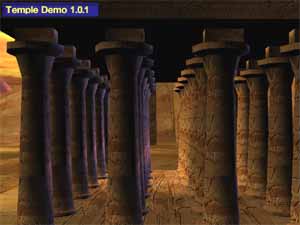
But real games do not usually have such a large overdraw, and tiles lose its advantage. And the fact that the KYRO II has a small fill-rate expresses itself negatively upon the games with complex graphics. Here is another example: AquaNoxThis game is due to appear at the end of this year. The AquaMark benchmark is based on it. It works in Direct3D and shows the card's operation in severe conditions of the complex scenes (the underwater world is very hard to represent since there must be a lot of light effects, flashes etc. for realistic images).  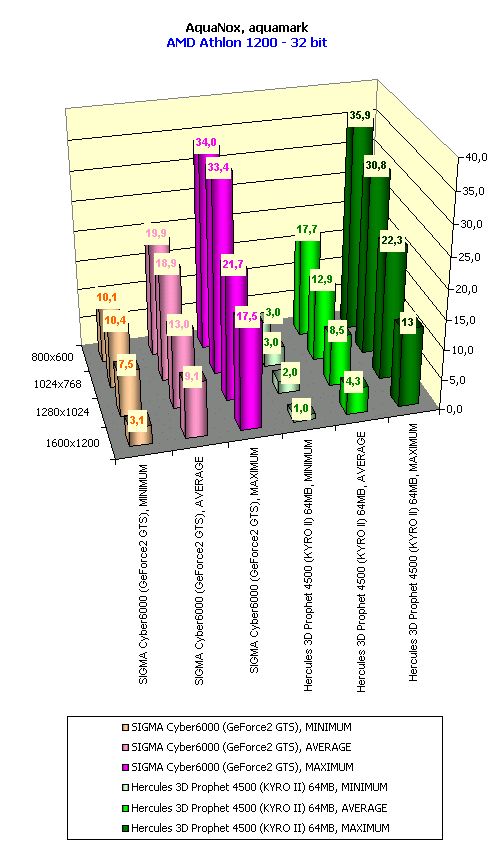 In this test apart from super-complex scenes overdraw is also high, that is why the GeForce2 GTS looks much worse and lag of the KYRO II is not so fatal. But with the increase of resolution the fillrate of the KYRO II is so low that the performance differs by several magnitudes. You can see that the playability of both cards is below the least acceptable level. Quality issuesThe quality issues were considered in details in the KYRO II review, I should only note that the worst disadvantage lies in the strong performance drop with the anisotropic filtering enabled. Besides, the latter works only in Direct3D; it is absent in the OpenGL despite the corresponding settings in the drivers. And even the latest version of drivers hasn't helped it. The trilinear filtering badly affects the performance. The KYRO II supports also the texture compression technology S3TC, that is why the cards on this processor show a good performance gain in games where compressed textures are used, or which support auto compression with much loss in quality. But there are not many such games. In the same review I have shown how the forced usage of the S3TC-technology could worsen the quality. ConclusionSo, on the one hand, the Hercules 3D Prophet 4500 shows excellent results on games without complex graphics, having a perfect "price/speed" ratio. On the other hand, in games with Hardware TCL support or with too complex graphics the KYRO II card is easily beaten by the competitors. Today users would hardly buy cards only for favorite games, since with such a stream of newly released games any can become popular, and if it is something like Giants, the beauty of the graphics, high quality of effects and high detailing level of the scenes will be out of sight. Another drawback is imperfection of the software (drivers), which doesn't ensure operation even of the specified functions. While for pre-production samples it is not so awful, for production cards it matters a lot. More thorough comparison data for this and other cards are given in our 3Digest, where you can also find the performance in one more test intended for Hardware TCL - 3DMark2001. Looking at such low results, I can't help grinning at the CD with drivers to Hercules 3D Prophet 4500 displayed at Cebit'2001 which has a writing saying that the KYRO II is able to replace cards with Hardware T&L. But with such a huge number of drawbacks, you should remember that the card will be priced close to the GeForce2 MX ones from other major brands. Another positive feature is the perfect quality in 16-bit color where the KYRO II outshines the more expensive cards. I hope also that the drivers will be debugged very soon. Highs:
Lows:
Write a comment below. No registration needed!
|
Platform · Video · Multimedia · Mobile · Other || About us & Privacy policy · Twitter · Facebook Copyright © Byrds Research & Publishing, Ltd., 1997–2011. All rights reserved. |